Salkantay to Machu Picchu Trek
The Salkantay Trek to Machu Picchu 5 days / 4 nights includes a visit to Humantay Lake on the first day of the tour.┬ĀThe entrance ticket to Machu Picc...
4 Days / 3 Nights
US$350
The Salkantay Trek to Machu Picchu 5 days / 4 nights includes a visit to Humantay Lake on the first day of the tour.┬ĀThe entrance ticket to Machu Picchu, our first option if available, is Circuit 2: Llaqta Machu Picchu / Classic Route 2-A, which takes you to the iconic panoramic viewpoint and allows you to explore approximately 70% of the citadel. If this circuit is unavailable, we will book Circuit 2-B: Lower Terrace, which also offers access to the classic viewpoint and lets you explore 60% of Machu Picchu.┬ĀTo secure one of these circuits,┬Āwe strongly recommend booking 4 or 3 months in advance.┬ĀHowever, if the circuits are already fully booked,┬Āwe will reserve the entrance for Circuit 3┬Āor 4 to ensure you have an amazing experience at Machu Picchu.
The famous Salkantay trek, named among the 20 Best Treks in the World by National Geographic Adventure Travel Magazine, is a trek open to everyone. Salkantay’s proximity to Machu Picchu makes this trek an attractive alternative to the Inca Trail. Come walk in the shadow of “The Savage Mountain” on the adventure of a lifetime!
In June 1st┬Ā 2024, a new regulation has been implemented with the aim of protecting and preserving the Machu Picchu citadel. Access to Machu Picchu has been reorganized into 3 distinct circuits, which are further divided into 10 types of tickets.
To explore the entire citadel of Machu Picchu, visitors must purchase two different tickets, each allowing entry to a separate circuit.┬ĀAdditionally, each circuit has specific schedules and a limited number of available spots, making it essential to plan your visit to Machu Picchu┬Ā3 to 4 months in advance. If you wish to combine different tickets for a more comprehensive experience, it is recommended to check the compatibility of the schedules. A┬Āminimum interval of two hours┬Ābetween entries is suggested, and at least┬Āfour hours┬Āif choosing the Machu Picchu Mountain or Huayna Picchu routes.
With this new entry system, visitors must board the bus to Machu Picchu┬Ā40 minutes to 1 hour before┬Āthe visit time printed on their ticket. This measure helps prevent unnecessary lines in Machu Picchu Pueblo and avoids crowding at the entrance gates to the Inca city.
For more detailed information about the different circuits and specific entrance schedules, we invite you to read this link on Schedules and New Circuits for Visiting Machu Picchu or to contact us directly. We can provide you with all the necessary information and address any questions you may have.
There will be┬Ātrekkers of different abilities┬Āand differnet lenguaje┬Āin your┬Ā Salkantay Trek group.┬ĀOur guides are very experienced and will work to accommodate the needs of all of our trekkers┬Āin a safe and friendly manner. However, if you and your friends or family all have the same fitness level and you would prefer to hike in a private group, contact us today about booking a private service for your Salkantay Trek adventure!
Please be aware this trek may not be suitable for travelers with vertigo.
The Salkantay Trek price includes a Machu Picchu entrance ticket.┬ĀThere are several circuits to explore the citadel, and at the time of your booking, we will secure the best available option. Our first choice, if available, is┬ĀCircuit 2: Llaqta Machu Picchu / Classic Route 2-A,┬Āwhich takes you to the iconic panoramic viewpoint and allows you to explore approximately 70% of the citadel. If this circuit is not available,┬Āwe will book Circuit 2-B: Lower Terrace,┬Āwhich also provides access to the classic viewpoint and allows you to explore 60% of Machu Picchu.
To ensure availability for one of these circuits,┬Āwe recommend booking your tour 3 to 4 months in advance. If neither of these options is available, weŌĆÖll select an alternative circuit that allows access to specific areas of Machu Picchu. You can find more details about the circuits in the link below
Accommodation During the Trek
Enjoy a comfortable and unique stay each night:
Each campsite is equipped with mattresses or sleeping pads;┬Āyou only need to bring your sleeping bag. If you donŌĆÖt have one, you can rent it at the Inka Trail Backpacker office. The campsites are designed for two people per unit, but they are spacious enough to comfortably accommodate three or four people. If you are traveling in a group of three or four and wish to stay together, this option is possible.
The luggage allowance has a weight limit of 6 kg per person.┬ĀDuring the informational briefing, you will receive a duffle bag where you can pack up to 6 kg of personal belongings, including your sleeping bag. Our team will transport these bags on horses throughout the trek, ensuring they are available at the campsites.┬ĀThis service allows you to hike comfortably with just your daypack. After completing your trek and returning to Cusco, you can leave your duffle bag at the Inka Trail Backpacker office for your convenience.
Starting at
$ 350.00USD
per person
We will start the trek by picking you up from your hotel between 4:30 a.m. and 5:00 a.m. And we will travel in our tourist transportation. After a 2-hour journey, we will make a brief stop at the Mollepata’s checking point, where each person will need to pay 20 soles to the local municipality (not included in the tour cost). After the stop, we will proceed to a local restaurant where you can enjoy a hearty breakfast. From Mollepata, we will continue driving for another one┬Ā hour┬Ā to┬Ā Challacancha, which will serve as the starting point for our hike.
Once in Challacancha , you will meet the cooks and horsemen, and we will do a final equipment check. Then, we will begin our journey. The initial part will be a 3-hour moderate walk to Soraypampa (3,900 m / 12,795 ft), where we will spend our first night. This section includes a relatively flat terrain with a slight uphill through a deep valley of glaciers. Along the trail, you will notice a restored Inca water channel that is still used by local farmers today. In total, this section covers 7 km / 4.35 miles
Once we reach Soraypampa, you will settle in at our exclusive Camp, where you will spend the night. After enjoying your first lunch in the mountains, you will have some time to rest. Then, we will embark on a hike to the breathtaking Humantay Lake (4,200 m / 13,780 ft).
The round trip to the lake takes approximately 3 hours, covering a distance of 3 km / 1.86 miles. Although not a long distance, it’s important to take it slowly due to the altitude. Once at the lake, you will have time to soak in the stunning scenery. Few places in the Andes match the beauty of the turquoise waters against the backdrop of the Humantay glacier. It will feel like stepping into a fairy tale!
Back at camp, you will enjoy a delicious and well-deserved dinner, accompanied by a beautiful sunset. The energy and peacefulness of this place are indescribable, and you will experience it firsthand. Later, you can retire to your igloo at the Sky Camp. The glass roof will allow you to gaze at the stars, constellations, and maybe even catch a glimpse of a comet. As you wake up, the majestic Apu Salkantay will be watching over you.
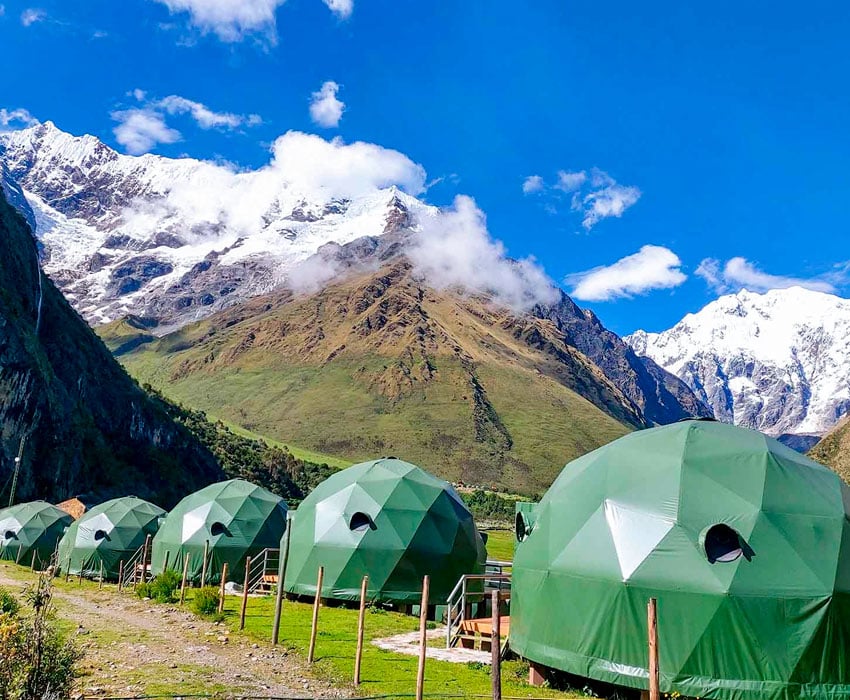


On the second day of the Salkantay trek 5 days you will┬Ā wake up with the light of the first rays of the day and an energizing coca tea to start the hike. Enjoy a nourishing breakfast before we set off on our trek to the routeŌĆÖs highest point, the Salkantay Pass (4,630 m / 15,190 ft). YouŌĆÖll be walking 7 km / 4.34 miles over 3 hours. ItŌĆÖs a difficult ascent up the ŌĆśtrail of the 7 snakesŌĆÖ rightly named due to its winding path.
Once you reach the top, youŌĆÖll appreciate the most magnificent view over the surrounding valleys as well as Salkantay Mountain sitting right next to you (6,271 m / 20,574 ft), which is the second-highest in the Cusco region and one of the Apus (Inca Gods). You can also observe Humantay, Tucarhuay, and Pumasillo mountains. After youŌĆÖve taken in the views and enjoyed a rest, youŌĆÖll start the 7 km / 4.35 miles walk downhill to the lunch spot in Huayracmachay (3,850 m / 12,631 ft), from where you can enjoy fantastic views.
This section of the trail is rocky and gravely, and you get some wonderful views down into the valley below. After a re-energizing lunch, youŌĆÖll be entering the edge of the Amazon jungle, also known as the ŌĆścloud forest.ŌĆÖ This part is 8 km / 4.97 miles and takes around 3 hours. Along the way, you get to enjoy a magical tropical forest and witness how quickly and dramatically the landscape changes from the Andes to the Amazon. YouŌĆÖll spot colorful scenery, unique wildlife, and native plants. YouŌĆÖll find the climate becomes much warmer here.
After your longest day of hiking, youŌĆÖll be pleased to reach our campsite at Chaullay (2,900 m / 9,514 ft). YouŌĆÖll be served a hearty meal before hitting the hay in your Andean hut for a peaceful nightŌĆÖs sleep in the small village. YouŌĆÖre sure to sleep well tonight!
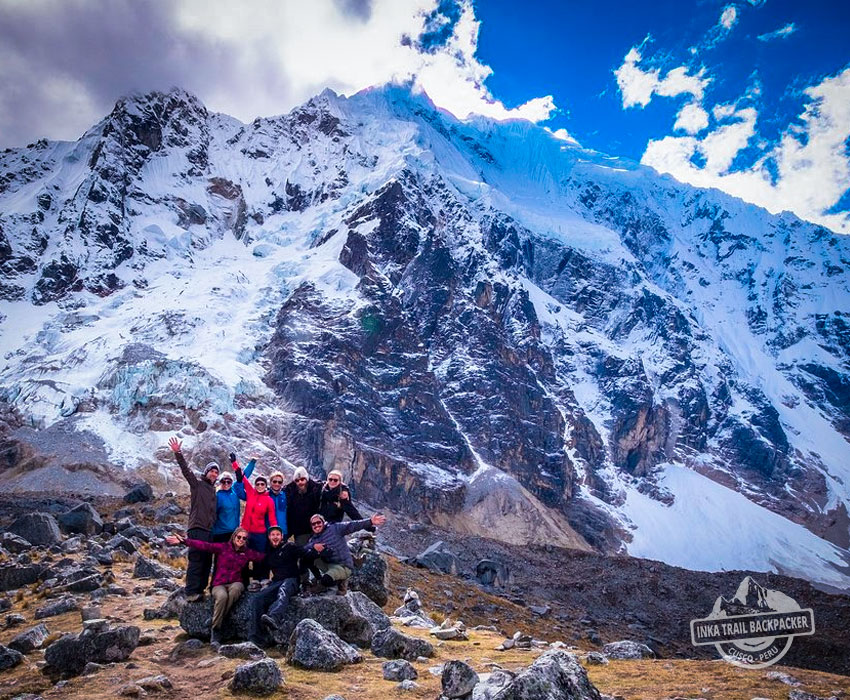


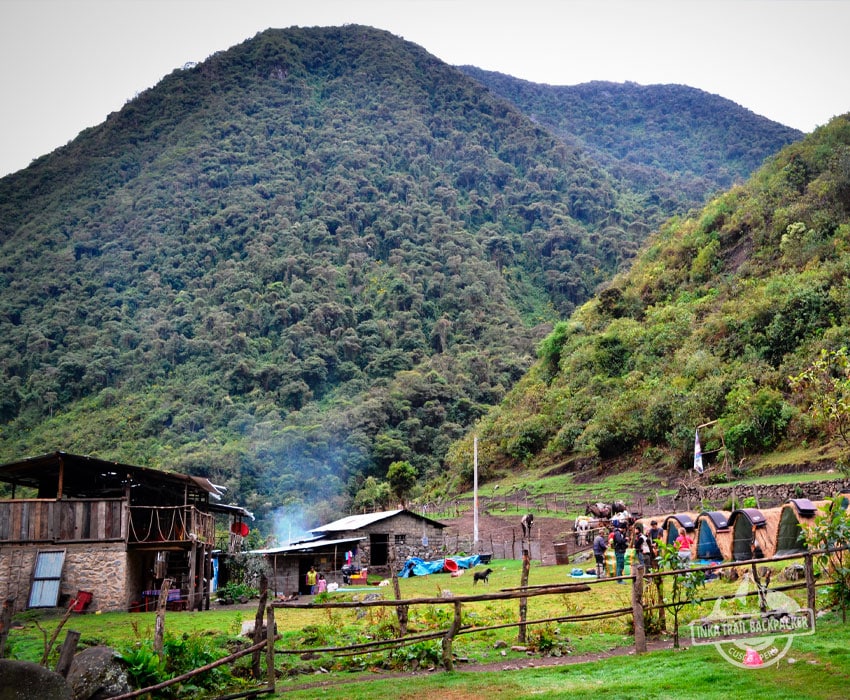
On the third day of the trek, awaken to the warmth and beauty of the lush jungle. At around 5:30 am, our cooks will serve you a cup of coca tea to help you start your day, followed by a scrumptious breakfast prepared to fuel your adventure.
At 6:30 am, embark on a 5-hour hike through the enchanting Santa Teresa Valley, shaped by the meandering Salkantay River. Your journey will lead you to Lucmabamba, the third campsite and your lunch destination, after 5 hours of trekking.
Throughout the hike, marvel at the thriving plantations of coffee, bananas, avocados, coca, passion fruit, and more. Upon arriving at the campsite, enjoy a delightful lunch before setting off to explore the optional hot springs of Colcampayo in Santa Teresa.
A 1.5-hour car ride will transport you to the Colcampayo hot springs, where you can unwind in the pristine, natural waters for a few hours before returning to camp for tea time, a delicious warm dinner, and a cozy group bonfire. Please note that the hots springs activitie is optional; if you prefer to relax at the campsite, you are more than welcome to do so.

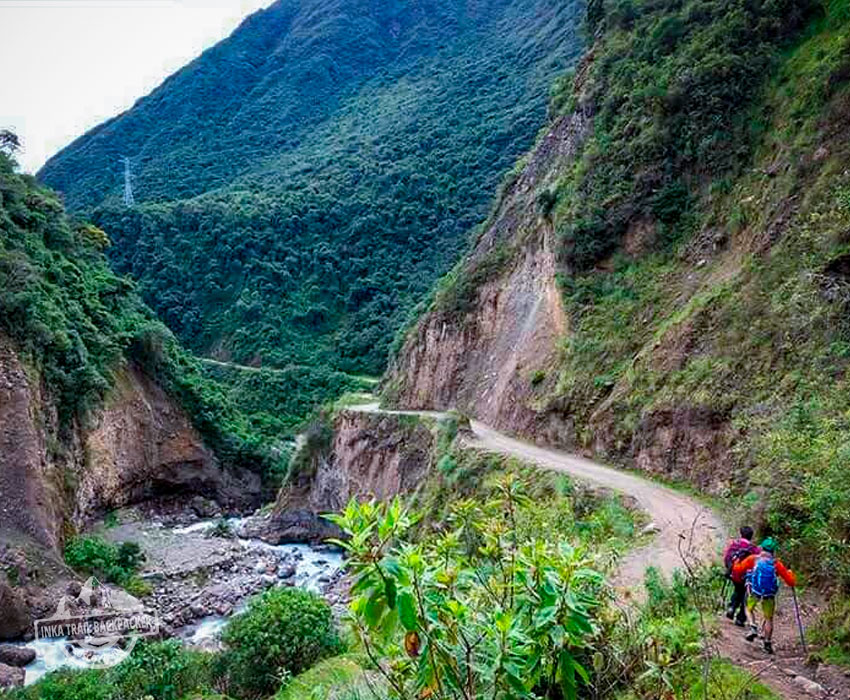


YouŌĆÖll be eager to put on your hiking boots for your last day of trekking after youŌĆÖve filled up on fuel at breakfast. This morning youŌĆÖll be able to walk along a bit of the original, world-famous Inca Trail! After a 2 hour uphill climb and fascinating views over the Santa Teresa Valley, youŌĆÖll reach Llactapata (2,700 m / 8,858 ft), an Inca archaeological site right in front of Machu Picchu.
Llactapata is the first Inca site youŌĆÖll see on the trek, and youŌĆÖll learn all about the mysteries of the ancient culture and the extraordinary site. You even get to have your first exciting glance of Machu Picchu and Huayna Picchu from here. Your guide will fill you in on all the history of the Incas while you take all the photos you want to share your fantastic experiences with friends and family back home.
Afterward, youŌĆÖll walk downhill for 1:30 hours, where you get another couple of peeks at the Inca citadel, Machu Picchu, along the way – only making your anticipation for tomorrow stronger. We stop for lunch in Aobamba before we continue on, for a half-hour, to Hidroel├®ctrica (1,800 m / 5,906 ft). One of the most impressive sites in this section is the 250-meter-tall artificial waterfall, which generates electricity for the entire city of Cusco.
Once in Hidroelectrica, you have a couple of options: 1) If youŌĆÖre tired out after all the trekking, you can opt to board a train to Aguas Calientes (US$ 35.00 extra). 2) If you want to enjoy the last stretch of the trek, you can enjoy the flat walk along the side of the tracks to Aguas Calientes, which takes around 3 hours. ItŌĆÖll be one more chance to enjoy your warm jungle surroundings as you hike.
Along the way, youŌĆÖll see Intihuatana, an ancient rock the Incas used as a sundial, which worked together with the sundial stone at Machu Picchu. These were used to measure and read the winter solstice, meaning the beginning of the farming season for the Incas. Next, youŌĆÖll reach the train tracks that lead to Aguas Calientes. Once in the small town, youŌĆÖll enjoy dinner at a restaurant and spend the night in a comfortable hotel.
Note: During the rainy season, the hike up the Llactapata Trail isnŌĆÖt 100% guaranteed due to safety concerns. When thereŌĆÖs frequent heavy rain, this trail can become very dangerous.
On this intense yet rewarding day, you will cover approximately 22 kilometers over the course of 8 hours of hiking. The trekŌĆÖs difficulty is considered challenging due to the distance and varied terrain. The lodging altitude in Aguas Calientes is 2,000 meters above sea level, providing a comfortable and relatively cooler environment for resting after the dayŌĆÖs hike.
Expect hot, humid, and tropical weather conditions as you journey through the lush landscapes. At the end of the day, you will be accommodated in a cozy hotel, offering a much-needed opportunity to relax and recharge. Throughout the day, you will be treated to a variety of nutritious and delicious meals, including breakfast, lunch, and dinner, to keep your energy levels high and spirits lifted.
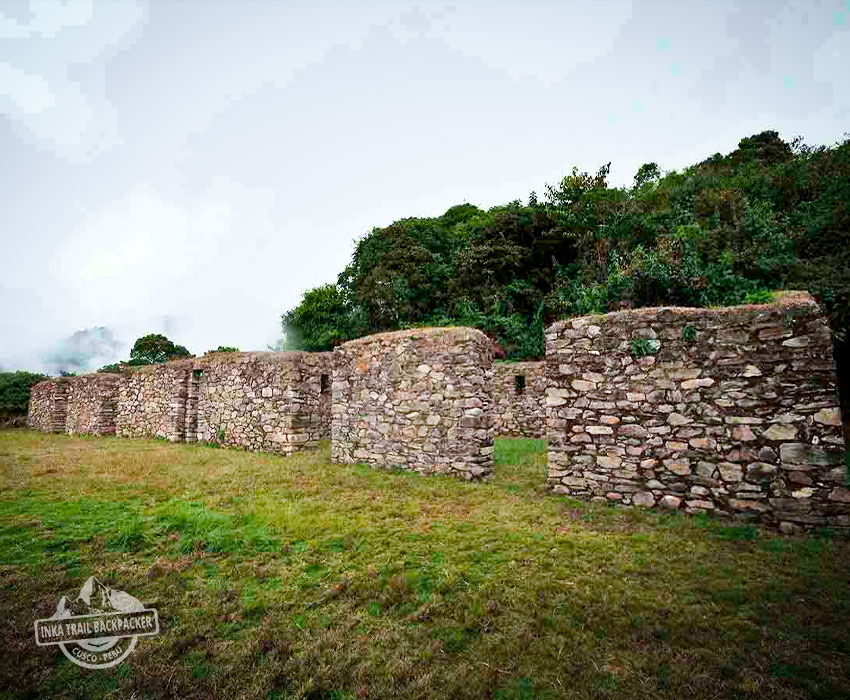

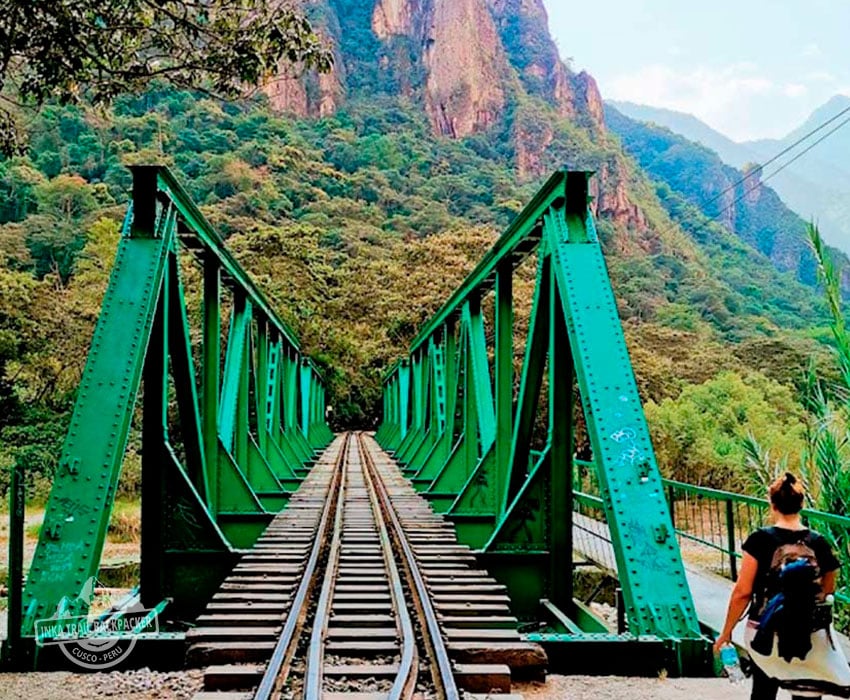

Arriving at Machu PicchuŌĆÖs Main Gate from Aguas Calientes: To reach Machu PicchuŌĆÖs main gate from Aguas Calientes, you have two options. You can either embark on a scenic 1.5-hour hike or take a convenient bus ride that costs $12. The choice is yours, and you can even decide on the same day you plan to visit Machu Picchu. Regardless of the option you choose, your day will begin bright and early at 4 am with a delicious breakfast at your hotel in Aguas Calientes.
If you choose to WALK from Aguas Calientes to Machu Picchu, your journey will begin at around 4:30 am. YouŌĆÖll start by walking from your hotel in Aguas Calientes to Puente Ruinas, which takes approximately 30 minutes. Puente Ruinas serves as the first checkpoint, where youŌĆÖll need to present your Machu Picchu tickets and original passports to gain entry. Once youŌĆÖve passed the Puente Ruinas checkpoint, youŌĆÖll embark on an uphill hike to Machu Picchu, climbing approximately 1,700 steps. This ascent typically takes between one hour to one hour and 20 minutes. Upon reaching the main gate of Machu Picchu, youŌĆÖll meet up with your group and guide to enter the site and begin your unforgettable exploration of this ancient Inca citadel.
If you opt to take the BUS from Aguas Calientes to Machu Picchu, youŌĆÖll need to purchase a bus ticket in town, either the night before or on the same morning. Each one-way bus ticket costs $12. Once you have your ticket, join the queue to board the first buses, which depart from Aguas Calientes at 5:30 am. The bus ride takes approximately 30 minutes to reach Machu Picchu. Upon arrival at Machu Picchu, youŌĆÖll meet up with your group and guide around 6 am to enter the site and begin exploring the remarkable ancient Inca city together.
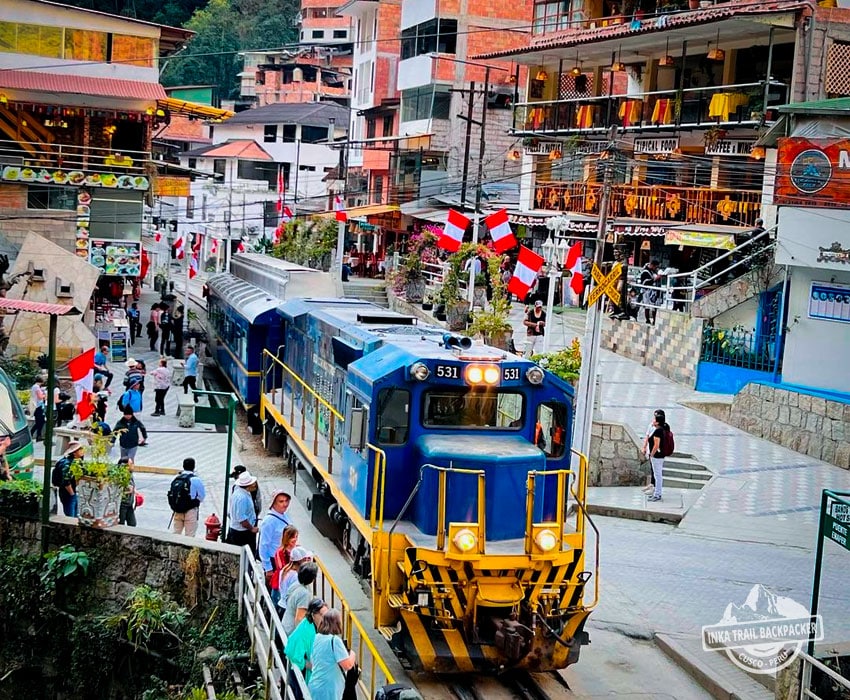

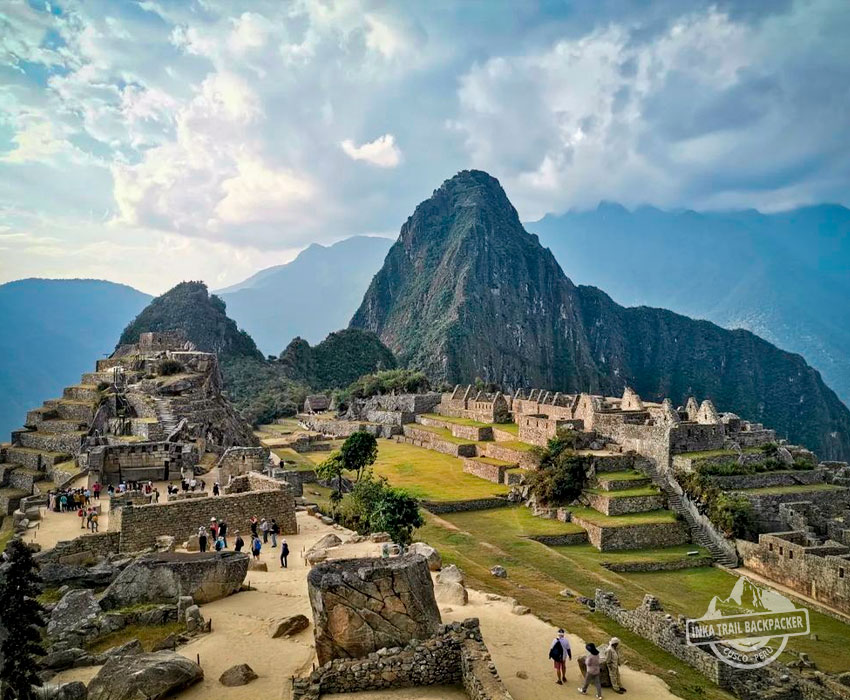

USD$250.00Per Person
This option is ideal for those who didn’t obtain Machu Picchu tickets in advance and may need to stay in Aguas Calientes for a few additional days to purchase tickets from local authorities while waiting in line.
USD$350.00Per Person
If the fourth day proves to be exhausting, we recommend spending an extra night in Aguas Calientes. This way, you can head to the Hidroel├®ctrica Station on the sixth day without rushing.
USD$410.00Per Person
To enjoy an exceptional experience on your Machu Picchu tour, we advise making reservations at least three months in advance.

Additional Upgrades for Your Salkantay Hike:
After your visit to Machu Picchu, you have two options for your return:┬Āby train or by car.
Generally, your train ticket will be scheduled for┬Ā2:30 p.m., 2:55 p.m., or 3:20 p.m.,┬Ādepending on availability. To reach the train station, you can either walk downhill for approximately┬Āone hour┬Āor take a┬Ā25-minute┬Ābus ride for┬Ā$12 USD.
You will have time to explore the charming town of┬ĀAguas Calientes, enjoy lunch, and relax before your trip.┬ĀPlease arrive at the train station at least 30 minutes before departure.
The train ride from┬ĀAguas Calientes to Ollantaytambo┬Ātakes approximately┬Ā1 hour and 40 minutes. Upon arrival in┬ĀOllantaytambo, a┬Ātransfer from Inka Trail Backpacker┬Āwill be waiting for you with your name. From there, you will travel in our┬Ātourist transport┬Āback to┬ĀCusco, a journey of┬Ā1 hour and 40 minutes, arriving at┬ĀPlaza Regocijo. Your estimated arrival in┬ĀCusco┬Āis around┬Ā6:30 p.m.
If you choose the┬Ācar return option, you will need to┬Āhike for 3 hours┬Āfrom┬ĀMachu Picchu to the Hydroelectric Station.┬ĀIt is important to start the hike before 11:00 a.m.
The route begins with a┬Ā30 to 40-minute descent, followed by approximately┬Ā2 to 3 hours of flat walking┬Āalong the train tracks.┬ĀYou must arrive at the Hydroelectric Station before 2:30 p.m.┬Āto board the transport at┬Ā3:00 p.m.
The car ride back to┬ĀCusco┬Āwill take between┬Ā6 and 7 hours, with an estimated arrival around┬Ā10:00 p.m., ending at┬ĀPlaza Regocijo┬Āin the city center.
At Inka Trail Backpacker, we offer you the basic and essential version of the popular treks in the region. We are a 100% local company that wants to provide everything you will need at the real cost of operationsŌĆönever unfair upcharging! That is why our slogan is ŌĆ£Fun, Not Fancy Trip.ŌĆØ
Inka Trail Backpacker has been a Licensed Inca Trail Tour Operator since 2014. All companies managing the Inca Trail must be certified and have an Inca Trail operators license. This license is issued annually each December; Inka Trail Backpacker is licensed through the year of 2027.
Our license as an Official Travel Agency is under the name Inka Trail Backpacker E.I.R.L. Our license as an Inca Trail Operator is under the name of INKA TRAIL BACKPACKER E.I.R.L We also work with partner company licenses, such as QESWACHAKA PERU TOURS┬Ā E.I.R.L and GRUPO CAMINOS DEL PERU E.I.R.L. For tourists┬┤protection, getting the permit for the Inca Trail from the government is a complicated and stringent process: in order to guarantee an Inca Trail Permit for all the tourists that have decided to book their adventure with us, we are registered to book using any of the above mentioned company licenses. We are all registered on the official Government web site: www.machupicchu.gob.pe.
Yes, we absolutely take care of our porters. We do not charge you less than other companies at the expense of our portersŌĆÖ pay and wellbeing. Since the end of 2014, Inka Trail Backpacker has been paying our porters a wage of 400 soles for the 4 day trek, plus their transportation costs. That is nearly 20% above the legally required minimum wage agreed upon with the Porters Union. Following talks with our porters, they have told us that they know of only a few trekking companies that offer such competitive pay and benefits. Only two companies pay slightly more (and charge their clients almost US$100 more than us). Of the remaining 170 other licensed trekking operators, only about 60% pay the legal wage and 40% pay less than the legal wage. Some companies pay only 70% of the legal wage. Unfortunately, this is difficult to prove as their porters receive a low wage but are asked to sign receipts showing they received more!
However, improving porter welfare is not just about paying fair wages. It is important that the porters have adequate food, a warm and dry place to sleep, and access to medical attention, just the same as any other member of the group.
The wages that the porters get paid are by no means high by Western standards, but you have to look at wages relative to other professions in Peru. For example, a school teacher gets paid the equivalent of about US$400 per month and has trained for 5 years to become a professional. A porter, if he works 4 treks a month, receives about the same if you include his tips. Most porters are seasonal workers and have no formal qualifications. For just 16 days work per month, they receive wages similar to a teacher who works 22 days. Inka Trail Backpacker also tries to help the porters in additional ways, such as financial and educational support for their families.
As a traveller, you know that one of the most rewarding and memorable experiences of going to new places is meeting people along the way. When you book a tour with us, you can be confident that your group will be filled with similar travellers looking for adventure in the Peruvian Andes. Our groups provide a great opportunity to meet new people and bond with them in an exciting environment. You never know who you will meet!
We are really proud of the work we do for our community. This is a main focus for our company. We have worked with villages directly to help supply them with needs, buy all our food from local farmers and markets, and serve the freshest ingredients.
At Inka Trail Backpacker, we like to think we do trekking a little differently than our competitors. We stand by our customers and guarantee that we meet 100% of our departure dates on our treks even if you are a solo traveler.
Our office is located at 392 Calle Triunfo (the street is also called Sunturwasi), inside the Centro Artesenal Arte Inka Building, which is on the corner across the street from the Museo Arzobispal and the Twelve-Angled Stone, by a small fountain. We are on the second floor, in Suite 209.
At Inka Trail Backpacker, providing a personal experience and ensuring you are thoroughly prepared for your trek is very important to us. Before you depart on the Inca Trail trek, you will receive a briefing in our office. At the briefing, you will get to meet our staff, receive maps and a detailed description of each day of your tour, be given duffel bags if you have hired a porter, and have the opportunity to ask questions.
When you pay with a credit card or PayPal, there is a 6% service charge added to the total cost of your tour. However, there is no service charge if you pay with cash; for this reason, the total cost of the tour will be higher when you pay with a credit card.
Our team of guides are all local to the Cusco area and speak both Spanish and English fluently. Many of them also speak Quechua (the native language of Peru). With degrees in tourism and with two years minimum of experience under their belts, they are full of energy, information about the native flora and fauna, and the Inca sites, with a vast knowledge of Andean stories and legends.
Yes, you must be moderately fit and exercise regularly to do this trek! In preparation, try walking fifteen kms per day or go to a fitness club in the months leading up to the trek. It is also important to be well acclimatised to the altitude. Try to spend at least three or four days in Cusco (3350m/11,047ft) prior to starting the Salkantay trek to Machu Picchu.
If you plan to renew or change your name on your passport between making your trek booking and starting your trek, you can book your trek or tour with your current passport number or name, but you must send us a copy of your old passport and a copy of your new passport when you have them. We can then make the change with the government before you arrive. The extra cost to make the change is US$25 per person. (This will cover the change in number or name for your Inca Trail Permit, Machu Picchu Entrance, and train.)
If you do not advise us of the change or do not want to pay the fee, bring the original of both passports (the old and new one). You can enter Peru with your new passport but you must show the government authorities your old passport in order to enter the Inca Trail, Machu Picchu or train. If you cannot do so, you will not be allowed to start your trek by the government officials. All names and numbers must match!!
Toilets have improved a lot in the last couple of years and all of the larger campsites have flushable toilets and running water. Overall, they are kept pretty clean. If you do need to use the toilet between campsites, then please defecate away from the trail and water supplies; you can dig a hole, or cover your feces with a rock, and take the paper with you in a bag to deposit in one of the several bins along the way.
Important: As a sustainable tourism operator that takes care of our porters we do NOT take portable toilets.
Tips for porters, cooks and guides are always welcome. The porters are also very grateful for small gifts, such as clothing and school equipment for their children. A normal amount is S/60-80 for each porter and S/120 for the chef. The group will pool money for the tip, this is not an individual amount.
If Inka Trail Backpacker fails to confirm the reservation, your payment will be refunded in full.
A participant must declare if he/she has any sickness or medical disorder and must bring his/her own medication. We recommend that you meet with a doctor before you book the trek if you have questionable health.
Always fresh and featuring organic ingredients, the food on the Inca Trail is always something to look forward to. There is always plenty to eat and lots of options including vegetables, meat, chicken, fish and other sources of protein and carbohydrates. On our tours, everyone sits down to eat together and enjoy each otherŌĆÖs company.
We offer standard meals as well as a vegetarian meal option. Just let us know if you want vegetarian meals when you book your trek.
Vegetarian meals have no red meat, chicken or fish. We will assume that eggs and dairy are OK. We are unable to cater specifically for vegans as it is too complicated for our cooks (remember they are cooking in a tent). Most of our main meals in the evening are served as a buffet service so you can always leave out what you donŌĆÖt like. If there is a particular food that you donŌĆÖt like (i.e. tomatoes, onions, mushrooms, etc) we will ask the cook to do his best to leave them out of the dish, but we cannot guarantee this. We can also cater to lactose-intolerant and gluten free diets (mild reactions only, no life threatening allergies accepted- see below). We reserve the right not to accept a trek booking based upon dietary requirements, this may be because we already have several people booked requiring special meals and donŌĆÖt want to further inconvenience our cook. Thanks for your understanding.
Standard (no dietary requirements, will eat everything)
Vegetarian
No red meat (chicken & fish ok)
No fish (red meat and chicken ok)
Lactose-free (mild reactions only)
Gluten free (mild reactions only)
Unfortunately, we donŌĆÖt offer a combination of the above i.e we donŌĆÖt accept vegetarian AND gluten-free.
You can leave any of your belongings that you do not want to bring on the trek at your hotel or hostel you were previously staying in. These hostels/hotels usually have a secure, locked room where you can store your belongings. If you do not trust your hostel, we would be more than happy to securely store your belongings for you.
The size of your group depends on the dayŌĆÖs activity. The maximum size of our Salkantay Trek┬Ā group service is 16┬Ā to 20 people. For groups of over 14 people, we also employ an assistant guide to help out (the assistant guide is a fully qualified guide but may lack some of the experience of the main guide or still need to improve his/her English skills.)
June, July and August are the most popular months to start this trek. As a result, you will encounter much larger crowds during these months. As an alternative, you can also hike from December to March.
During the months of December to April, you can expect rain showers three to four afternoons a week. If you do not mind a little drizzle and muddy trails, hiking during the rainy season should not be a problem. During the rainy season, there are smaller crowds and greener hillsides. Frequently, you will see wildflowers and orchids in bloom.
We require everyone to be in Cusco at least two nights prior to starting the trek, although three nights is even better. You must pay your trek balance at least two days before the trek departure. For example, if your trek departs on a Monday you must come to our office before 7:30 pm on Saturday to pay the trek balance. This ensures that everyone in the group is well acclimatized to the high altitude before starting the trek.
It is very important to be well acclimated before exerting yourself on a trek. This is why we require everyone to be in Cusco for a minimum of two days prior to regular treks like the Inca Trail. However, if you are doing the Salkantay Trek, you will need at least four days to acclimate because this trek occurs at much higher altitudes than Cusco. You can use this time spent acclimatizing to visit the city of Cusco, nearby Inca ruins, and the Sacred Valley of the Incas.
No, sneakers are not recommended for the Salkantay Trail! The terrain is very steep, with loose gravel, puddles, mud, and other obstacles. You must have sturdy, waterproof footwear designed for this type of terrain, with good traction and ankle support. Be sure to break in your hiking boots before your trek! Wear them on several shorter walks or hikes before your trip, so that your feet can get used to them.
If you do not have hiking boots, or they are too bulky for your suitcase, you can rent them in Cusco for under one hundred soles.
To avoid altitude sickness on the trek, we recommend that you spend time in Cusco or in the Sacred Valley beforehand. If you have never been in high altitude, we recommend that you first spend a day in the Sacred Valley, because it is at a lower altitude than Cusco city.
All of the treks are fairly difficult and you should be well prepared and healthy prior to starting the trek. You have to be moderately fit to complete this hike. To prepare, try walking 15km a day or start going to the gym a month before the trek. We will cover a lot of distance in the first two days of this trek.The good news is that everyone in the last few years who has started a trek has finished it! If you are really struggling, we have emergency horses that you can ride if you are not fit for the trek.
As of July 1st, 2017, tourists will be able to access Machu Picchu ┬Āfrom either 06:00 to 12:00 or from 12:30 to 17:30. Given this limit, we highly recommend that you book your tour far in advance, especially if you are interested in going during the peak tourist season (May to September). Machu Picchu entrance tickets and train tickets are often sold out weeks in advance.
Our sleeping bags are rated for temperatures as low as -10┬░C, but are more suitable for temperatures of about -5┬░C. Since you wonŌĆÖt find temperatures as low as this on the trek, we rate them as very warm and cozy! We charge US$20 per person for the whole trek.
Yes, all our tour guides take an oxygen bottle with them along the trail and will provide oxygen as needed.
On the morning of the trek departure, we will pick you up from inside your hotel in Cusco (donŌĆÖt wait outside in the street) and drop you off either in the Plaza de Regocijos ( next to the main square) or Plaza San Francisco (two blocks from the main square) upon your return to Cusco. You wonŌĆÖt be dropped off directly at your hotel/hostels.
It helps us if you try to stay in a hotel/hostal that is within a few blocks of the Plaza de Armas (Main Square). If your hotel/hostal is far away from the main square we will ask you to come to our offices with the exact location and name of your accommodation.┬ĀIf you are not staying in the city center,┬Āwe cannot pick you up from your hotel. You must take a taxi to the center.┬Ā
The guide will come into your hotel and ask for you at reception. Because the centre of Cusco is full of small cobblestone streets, our larger bus/van is not permitted to enter certain zones in the city centre, so you will then have to walk a short distance to where the bus/van will be waiting for you. Traffic regulations prohibit large buses/van from entering the main square but usually after 10pm we donŌĆÖt have a problem and will be able to drop you off in the main square upon your return. You can then take a taxi back to your hotel (between US$2 to US$4 for a taxi).
If we have to drop you off in Plaza San Francisco, you may be a bit disoriented (some people may need to be woken up!!) but we recommend that you ask for directions to the Plaza de Armas and our guide or driver will be happy to help. ItŌĆÖs only two blocks away, but usually itŌĆÖll be quite late at night so it is best to walk together as a group back to the Plaza before taking a taxi or walking back to your hotel.
All of our former trekkers agree that the coldest campsite along the trek is the first basecamp: during the nighttime, temperatures can drop below freezing! This is especially true during the months of June, July, and August. However, the second and third campsites are also fairly cold. Please keep these temperatures in mind when you pack for the trek.
Your entrance time to Machu Picchu will depend on when you book your trek. As of July 1, 2017, there are two possible entry times to the site: 6:00 am to 12:00 pm, or 12:00 pm to 5:00 pm. Your ticket will grant you entry for either the morning or the afternoonŌĆönot both. The morning entry is significantly more popular and quickly sells outŌĆöunless you book your trek two to three months in advance, we cannot guarantee a morning entry.
If you book far enough in advance to secure a morning entry, you will start to hike up to Machu Picchu at 4:30am, arriving at the site by about 6:00 amŌĆöjust in time for the sunrise!
Yes, the Machu Picchu entrance is included in the tour package.
No, as a company, we do not have any hidden costs which is why we list everything that is not included in our tour on our own website. However, we highly recommend that you take some extra money with you on the trek (about 300 soles, at least). Small bills in soles are recommended.
You can recharge batteries on the second day, but there will be a cost of 15 soles per battery.
Yes, all meals are included except the first breakfast on the first day, and lunch/dinner on the last day.
At meal times we will give you tea, coffee, etc to drink. During the trek, you may have to buy water directly from the local people, which is possible approximately every two hours and at each campsite. Remember that the price of the water will be much more expensive than in the city.
Bottled mineral water can also be taken from Cusco, bought at Mollepata (the start of the trek), at Soraypampa (first night), and at Chalhuay (second night).
You may also use local water sources. You’ll come across a mountain spring, fountain or small stream approximately every two hours along the trail where you can fill up your water bottle. Many people complete the trek without ever having to use water taken from streams , but sterilizing tablets are recommended for emergencies.
Many toilets have been built along the way, including at all of the campsites, and you may use them for a small fee (approximately one sole). This has helped a lot to improve sanitary conditions on the trail, although conditions are still not always perfect.
We recommend that you bring hand-sanitizer to use after visiting the public toilets.
For the Salkantay Trek, we give you a weight allowance of 5 kilos/10 pounds per person, to be carried by our horses. ┬ĀThis weight limit includes your sleeping bags. However, the horses┬Āwill not walk at your side during the trek: you will still need a day pack to carry essential items such as water, snacks, your camera, a warm sweater and a rain jacket.
Our┬Āhorses will only be able to join you for the first day and second day┬Āof the trek. The rest of the time, our porters will be responsible for all the heavy lifting.
We require a minimum group size of just five people. During the last few years, Inka Trail Backpacker has always managed to meet the minimum group size for ALL of our departure dates and has never had to cancel any group departures due to group size.
In the unlikely event that we do not reach the minimum required number of persons, we reserve the right to combine our clients with another trekking company of similar cost.
If you are traveling alone and are willing to share a tent with another participant of the same genre, then there is no additional cost. If, however, you would prefer your own tent, there is an additional supplement of US$40.
No, transportation to and from the airport is not included in your tour. Please plan accordingly.
As of July 1, 2017, visitors to Machu Picchu must follow one of three circuits through the site with their guide. Circuit 1 is the most physically demanding, and follows the classic route through the upper portion of the site before curving down to the lower portion. Circuits 2 and 3 will take you through the middle and lower portions of the site. You must choose which circuit you want when you buy your ticket.
The train travels between the town of Ollantaytambo in the Sacred Valley and Aguas Calientes, a small town located fifteen minutes below the Machu Picchu complex. The journey from Ollantaytambo to Aguas Calientes is an hour and forty minutes. (The return journey will be about three and a half hours, because the drive from Ollantaytambo station to Cusco is about an hour and forty minutes.) From Aguas Calientes, it is either a fifteen minute bus ride or hour hike up to Machu Picchu. There is no direct train from Cusco to Machu Picchu. Although there is an additional station located at Poroy, about 25 minutes from Cusco, it is not always open. Train service from Ollantaytambo, meanwhile, is constant and reliable. Furthermore, taking the train from the Poroy station extends the total length of your journey between Cusco and Aguas Calientes to more than four hours, instead of three and a half.
We always book through the Continental, El Tambo or Machu Picchu hostels in Aguas Calientes, which offer private double rooms. These hostels offer comfortable beds, hot showers, WiFi, and breakfast.
However, we can only guarantee these hostels will be reserved for you if you book your trek 2 months in advance. Otherwise, we may be forced to offer you an alternative hostel to stay in.
Every traveller has their own expectations for accommodation and that is why we offer you the option to book your own hostel independently. The three hostels that Inka Trail Backpacker books are considered basic and if you wish to upgrade to a hotel you need to either do this yourself or ask us to book the new hotel for you.
If you wish to book a hostel independently, a US $10 discount is given per person off the tour price. You can use this money to pay for an alternative hostel.
Before traveling to Peru, you should consult your doctor. Routine vaccines, Hepatitis A, and typhoid vaccines are recommended for most travelers by the CDC. Some travelers may also need vaccines for Hepatitis B, rabies, and yellow fever. Women who are pregnant or may become pregnant should also be advised that the Zika virus is present in Peru.
Malaria pills are not necessary for these treks.
The rainy season in Cusco is generally from November to April, when there are near-daily showers and the groundŌĆöespecially in trekking areasŌĆöis wet and muddy. However, there are occasional showers throughout the rest of the year; you should always pack a rain jacket, regardless of when you plan to visit. For treks, a rain poncho is highly recommendedŌĆösince you will be walking through rain for potentially several hours without shelter, a poncho will be much more effective at keeping all of your belongings and your base layers warm and dry. Waterproof shoes are also strongly recommended.
In the event of illness or injury, we will offer all of the support and care we are able; however, you should carry any medications you expect to need with you (ask your doctor for specific recommendations or prescriptions for altitude sickness, traveler┬┤s diarrhea , colds and sore throats, and pain or inflammation). If you are not capable of completing the trek, we will transport you back to Cusco, where you can seek medical treatment. However, the cost of this transportation is not included in your tour and you will be expected to pay the additional expenseŌĆöfor this reason, we highly recommend travel insurance for your trek.
Yes, in all of the hostels that we book for you, you will have a private room and bathroom.
Although not required, walking poles are recommended for any trekkers worried about joint stress or balance. They also are quite helpful in providing stability and leverage on especially steep climbs and descents. If you do not have poles or are unsure how to use them, we are able to rent them to you and provide instruction.
As of July 1, 2017, you must have your original passport to enter Machu Picchu. You also need to have your entrance ticket, which your guide will give to you at the appropriate time. The passport that you bring to Machu Picchu must be the same one that you used to book your tour and entrance; if you change or renew your passport between booking and your trip, please be sure to bring the originals of both.
Photos from our travellers
The Salkantay Trek to Machu Picchu 5 days / 4 nights includes a visit to Humantay Lake on the first day of the tour.┬ĀThe entrance ticket to Machu Picc...
4 Days / 3 Nights
US$350
This activity-filled tour is perfect for those who want to see the best of the Sacred Valley before visiting the world famous Machu Picchu. This tour...
2 Days / 1 Nights
US$400
This the shorter version of the 4 Day Inca Jungle trail. This tour was created for those who are seeking more adventurous activities such as biking, r...
3 Days / 2 Nights
US$280
Inca Jungle trek to Machu Picchu 4 days / 3 nights includes the entrance ticket to Machu Picchu, our first option if available, is Circuit 2: Llaqta M...
4 Days / 3 Nights
US$300
The Salkantay Trek to Machu Picchu 5 days / 4 nights includes a visit to Humantay Lake on the first day of the tour.┬ĀThe entrance ticket to Machu Picc...
5 Days / 4 Nights
US$350
The Cheapest Choquequirao Trek is perfect for those looking to get away from the crowds or who are looking for something other than Machu Picchu durin...
4 Days / 3 Nights
US$550